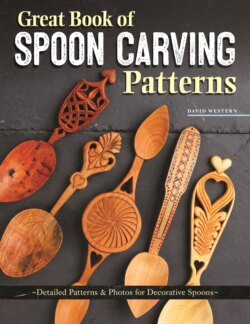Читать книгу Notes from a Swedish Kitchen - David Western - Страница 10
На сайте Литреса книга снята с продажи.
ОглавлениеTools
Although it is easy to get carried away when it comes to acquiring carving gear, it’s important to remember that during the golden era of the romantic spoon, the vast majority of designs would have been carved with only the most basic of tools. Over the years, the growing accessibility of quality hand tools and the invention of power tools have changed everything for woodworkers of all stripes. Unfortunately and somewhat strangely, along with the ease and efficiency of machining seems to have come an equal loss of elegance and beauty. Today, the best spoons largely remain those crafted by hand, but this is not to say that power tools don’t have a place in romantic spoon carving. As the Shakers discovered while building their remarkable furniture, machines can deal with the drudgery and monotony of many tasks, leaving the crafter more time and energy to devote to creating high-quality works of art.
THE ESSENTIAL TOOLKIT
This simple collection of tools is similar to that which might have been available to farm workers from Wales and the Continent during the 1600s to 1800s. It will serve you just as well.
Straight knife: The straight knife is the tool most used in spoon carving. Whether used for rough-shaping, tidying, or the finest detail cutting, the straight knife is tremendously versatile. Larger knives are more suited to rapid stock removal, and smaller knives are most useful for detailing and delicate cutting. Most carvers will eventually accumulate a number of straight knives in a variety of lengths and shapes, but a good-quality knife approximately 1 inches (3.8cm) in length with a finely pointed tip is an ideal tool to begin a collection.
Adze and axe
Bent/hook knife: As the name implies, a bent knife has a curved blade that allows the cutting of concave surfaces. The ideal tool for shaping the spoon’s bowl, it is a vital part of the toolkit and is very nearly as important as the straight knife. In Wales, carvers would often make their own bent knife blades from broken bucket handles, files, or scraps of metal from plowshares. On the Continent, the knives tended to be more of the hook knife style with a deeper and more circular blade shape. Either works fine and will also allow you to carve other detailing, such as textured surfaces, curved foliage, and deep hollows without the need for masses of expensive carving gouges.
Axe/adze: For removing stock rapidly and rough-shaping spoon blanks, there is no better hand tool than the axe. Although it is very much a learned skill and carries some inherent dangers, swinging an axe is an efficient and swift way to work wood during the initial stages of a carving. A straight-bladed axe will carry out the same functions as a straight knife, only on a much grander level. For concave cutting, such as shaping a curve into a handle or even roughshaping a bowl, an adze is the perfect hand tool. Sometimes, it is possible to acquire a sculptor’s adze that conveniently combines an axe and an adze on the same handle.
Straight knives
Bent/hook knives
Sharpening stones/papers: To properly maintain cutting edges and ensure that all tools are in top working order, you must have some good-quality sharpening tools on hand. At the very minimum, a combination 1000X/4000X Japanese waterstone will keep tool edges refined and very sharp. Adding some super-fine paper abrasives that have been designed for tool sharpening allows for a very economical but highly efficient sharpening system. The addition of a leather strop and polishing paste will enable you to hone blades to a razor-sharp edge.
ADDITIONAL TOOLS
As mentioned earlier, it is easy to get carried away with tool purchases, especially when it comes to carving gouges and chisels. Rather than buy entire sets (most of which will remain in the box for years on end), buy tools on an as-needed basis. This will ensure a collection that is best suited for the type of work you do and will save a lot of money. Gouges are supremely useful for cutting concave surfaces and can be used to robustly remove stock or delicately shape fair surfaces from spoon bowls to flower petals. They exist in a bewildering array of widths and sweeps (the term for the curve of the blade). Begin your collection with a ½-inch (1.3cm)–wide shallow tool like a #5 sweep and a ½-inch (1.3cm)–wide deep tool like a #9 sweep, adding more shapes as you need them.
Two tools which are often overlooked but are ideal for spoon carving are the file and the scraper. Files allow you to undertake shaping and smoothing that would usually be done with sandpaper, allowing for a fine and clean surface free of sandpaper’s microscopic grit particles that can dull cutting edges. Scrapers are another alternative to abrasives that enable the paring off of wafer-thin shavings from even the most difficult of wood grains.
There is no doubt that power tools have completely changed the face of woodcarving in the last 150 years. For rapid stock removal, nothing beats a band saw, a scroll saw, and a drill press. A band saw is ideal for milling down log lumber into useful carving billets and for roughshaping the exterior lines of spoon patterns. A drill press can accurately drill away excess interior wood and allow for the easy threading of scroll saw blades for detail cutting. A scroll saw is probably the most versatile of the power tools for a spoon carver, allowing shaping of the blank, cutting of fine interior details, and, when fitted with a sanding attachment, power sanding.
Gouges come in many shapes and sizes, but you will probably only require a select few for your spoon carving.
Scraper
File
